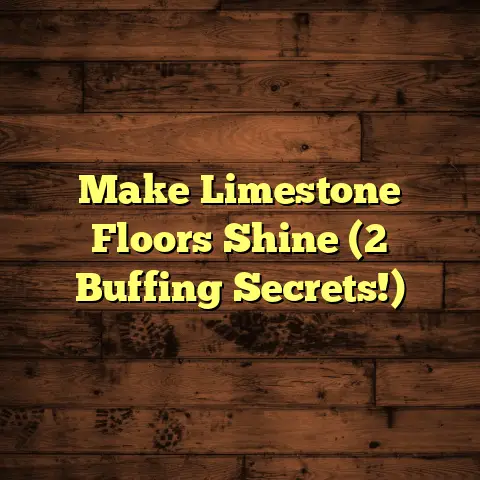DIY Concrete Floors? (10 Cracks to Watch!)
Concrete flooring is not just a trend; it’s a revolution in home design that promises durability and style.
But beware—the beauty of your DIY project can be marred by cracks that tell a story of neglect and poor execution.
As a flooring contractor with years under my belt, I’ve seen it all – the good, the bad, and the cracked.
Let’s dive into the world of concrete floors and those pesky cracks!
Understanding Concrete Flooring
So, what exactly is concrete flooring?
Simply put, it’s a floor made of concrete – a mixture of cement, aggregates (like sand and gravel), and water.
Unlike traditional materials like wood or tile, concrete offers a raw, industrial aesthetic that’s super versatile.
Why concrete?
-
Durability: It can withstand heavy foot traffic and resist damage.
-
Versatility: You can stain, polish, or stamp it to achieve different looks.
-
Cost-Effective: Often cheaper than hardwood or high-end tiles.
-
Sustainable: Uses readily available materials and can incorporate recycled content.
I’ve noticed a huge surge in DIY concrete floors lately. Homeowners and designers are drawn to its modern vibe and potential for customization.
From sleek, polished surfaces in living rooms to rugged, stained concrete in basements, the possibilities are endless.
Concrete is used everywhere:
-
Residential: Kitchens, living rooms, basements, bathrooms.
-
Commercial: Retail stores, restaurants, offices.
-
Outdoor: Patios, walkways, driveways.
The Cracking Dilemma
Now, let’s talk about the elephant in the room: cracks.
Why do they happen?
Well, concrete isn’t invincible. It’s a “living” material that expands and contracts with temperature and moisture changes.
Think of it like skin – it stretches and moves, and sometimes, it cracks.
Common causes of cracks:
-
Shrinkage: Concrete shrinks as it dries and cures.
-
Temperature Changes: Expansion and contraction due to heat and cold.
-
Improper Installation: Poor mixing, pouring, or curing.
-
Settlement: Ground movement beneath the slab.
Concrete experiences stresses from day one.
It’s crucial to understand these stresses to prevent or minimize cracking.
Crack #1: Hairline Cracks
Hairline cracks are those super fine, barely visible lines you might see on your concrete floor.
They often appear during the curing process as the concrete loses moisture and shrinks.
Think of them as the concrete’s way of relieving tension.
Are they a concern?
Usually, no. Hairline cracks are often cosmetic and don’t compromise the structural integrity of the floor.
However, if they’re widespread or deepening, it’s worth investigating further.
How to identify a concerning hairline crack:
-
Width: If it’s widening over time.
-
Depth: If you can feel it with your fingernail.
-
Location: If it’s near a structural element like a wall or column.
In my experience, most hairline cracks are just part of the concrete’s natural aging process.
Crack #2: Shrinkage Cracks
Shrinkage cracks are more significant than hairline cracks.
They occur when the concrete shrinks excessively during the curing process.
This happens because the water in the concrete mix evaporates, causing the volume to decrease.
Conditions that lead to shrinkage cracks:
-
High Water Content: Too much water in the mix increases shrinkage.
-
Rapid Drying: Curing too quickly, especially in hot weather.
-
Lack of Control Joints: These joints allow the concrete to shrink without cracking randomly.
Preventive measures:
-
Use the Right Mix: Follow the recommended water-cement ratio.
-
Proper Curing: Keep the concrete moist for at least 7 days.
-
Install Control Joints: These create planned weak points for cracking.
Addressing existing shrinkage cracks:
-
Small Cracks: Can be filled with a concrete crack filler or epoxy.
-
Large Cracks: May require professional repair, such as routing and filling with a flexible sealant.
I’ve seen countless floors ruined by improper curing. Take your time and do it right!
Crack #3: Settlement Cracks
Settlement cracks are serious business.
They indicate movement in the ground beneath the concrete slab.
This can be caused by soil erosion, poor compaction, or unstable soil conditions.
Differentiating settlement cracks:
-
Location: Often near walls or foundations.
-
Width: Typically wider than shrinkage cracks.
-
Displacement: One side of the crack may be higher than the other.
Structural issues to watch for:
-
Cracks in Walls: Can indicate foundation problems.
-
Uneven Floors: Noticeable sloping or sinking.
-
Doors and Windows: Difficulty opening or closing.
Assessing severity:
-
Monitor the Crack: Measure its width and depth over time.
-
Consult a Structural Engineer: If you suspect foundation issues.
I always tell my clients: “When in doubt, call a professional!”
Crack #4: Expansion Cracks
Expansion cracks are caused by temperature fluctuations.
As the concrete heats up, it expands; as it cools down, it contracts.
If the concrete can’t move freely, it will crack.
Importance of control joints:
Control joints are pre-planned grooves in the concrete that allow it to expand and contract without cracking randomly.
They act as relief valves, directing the stress to a specific location.
Tips for expansion cracks:
-
Proper Spacing: Control joints should be spaced appropriately based on the concrete thickness and environmental conditions.
-
Flexible Sealant: Fill control joints with a flexible sealant to prevent water and debris from entering.
-
Monitor and Maintain: Check control joints regularly and repair any damage.
In areas with extreme temperature swings, expansion cracks are almost inevitable without proper control joints.
Crack #5: Spalling
Spalling is when the surface of the concrete starts to chip, flake, or break away.
This is often caused by freeze-thaw cycles, where water penetrates the concrete, freezes, and expands, causing the surface to break apart.
Conditions that lead to spalling:
-
Freeze-Thaw Cycles: Common in cold climates.
-
Moisture: Water penetration into the concrete.
-
Salt: De-icing salts can accelerate spalling.
Impact of spalling:
-
Aesthetic: Unsightly pitting and flaking.
-
Functional: Can create tripping hazards and weaken the concrete.
Repairing and preventing spalling:
-
Remove Loose Concrete: Chip away any loose or damaged material.
-
Clean the Surface: Thoroughly clean the area.
-
Apply a Concrete Patch: Use a high-quality concrete patch to fill the damaged area.
-
Seal the Surface: Apply a concrete sealer to protect against moisture.
I’ve seen spalling turn beautiful floors into eyesores. Sealing is key!
Crack #6: Scaling
Scaling is similar to spalling, but it involves the loss of a thin layer of the concrete surface.
It often appears as a flaky or powdery surface.
Causes of scaling:
-
Poor Finishing: Improper finishing techniques can weaken the surface.
-
Early Freezing: Freezing of the concrete before it has fully cured.
-
Salt Exposure: De-icing salts can cause scaling, especially in outdoor applications.
Preventive measures:
-
Proper Finishing: Use appropriate finishing techniques.
-
Protect from Freezing: Cover the concrete during cold weather.
-
Avoid Salt: Use alternative de-icing methods.
Repair options:
-
Surface Grinding: Grind away the damaged surface.
-
Concrete Overlay: Apply a thin layer of new concrete over the existing surface.
Scaling can be tricky to fix, so prevention is definitely the best approach.
Crack #7: Corner Cracks
Corner cracks are cracks that form at the corners of concrete slabs.
They’re often caused by stress concentrations in these areas.
Common causes:
-
Improper Curing: Inadequate curing can weaken the corners.
-
Heavy Loads: Concentrated loads near the corners.
-
Lack of Support: Insufficient support beneath the corners.
Repair and prevention:
-
Proper Curing: Ensure thorough curing, especially at the corners.
-
Reinforcement: Add reinforcement (like rebar) near the corners.
-
Load Distribution: Avoid placing heavy loads directly on the corners.
-
Epoxy Injection: Inject epoxy into the crack to bond the concrete back together.
I’ve seen corner cracks develop in garages where heavy equipment is stored.
Crack #8: Surface Cracks
Surface cracks are shallow cracks that only affect the surface of the concrete.
They’re usually cosmetic and don’t compromise the structural integrity of the floor.
Difference from deeper cracks:
-
Depth: Surface cracks are typically less than 1/8 inch deep.
-
Width: They’re usually very narrow.
-
Structural Impact: They don’t affect the load-bearing capacity of the concrete.
How surface cracks affect appearance:
-
Unsightly Lines: Can detract from the overall look of the floor.
-
Dust Accumulation: Cracks can trap dust and dirt.
Filling and disguising surface cracks:
-
Concrete Crack Filler: Apply a thin layer of concrete crack filler.
-
Color Matching: Match the filler to the color of the concrete.
-
Sealing: Seal the surface to prevent further cracking.
Surface cracks are more of an aesthetic issue than a structural one, but they’re still worth addressing.
Crack #9: Random Cracks
Random cracks are unpredictable cracks that can appear anywhere on the concrete surface.
Their causes can be varied and sometimes difficult to pinpoint.
Potential causes:
-
Uneven Curing: Differential curing rates across the slab.
-
Localized Stress: Stress concentrations due to uneven loads.
-
Subgrade Issues: Problems with the soil beneath the slab.
Assessing random cracks:
-
Monitor the Crack: Check for widening or deepening over time.
-
Inspect the Surrounding Area: Look for signs of settlement or other issues.
-
Consult a Professional: If you’re unsure about the cause or severity.
Strategies for addressing random cracks:
-
Filling: Fill the crack with a concrete crack filler or epoxy.
-
Overlay: Apply a concrete overlay to cover the crack.
-
Sealing: Seal the surface to prevent further cracking.
Random cracks can be frustrating, but often they’re just a minor imperfection in an otherwise solid floor.
Crack #10: Leaking Cracks
Leaking cracks are cracks that allow water to penetrate the concrete.
They can lead to water damage, mold growth, and structural problems.
Importance of prompt action:
-
Prevent Water Damage: Stop water from seeping into the concrete.
-
Avoid Mold Growth: Prevent mold from growing in damp areas.
-
Protect Structural Integrity: Prevent water from weakening the concrete.
Repair techniques:
-
Epoxy Injection: Inject epoxy into the crack to seal it.
-
Polyurethane Injection: Use polyurethane to seal the crack.
-
Surface Sealant: Apply a waterproof sealant to the surface.
Long-term solutions:
-
Improve Drainage: Ensure proper drainage around the foundation.
-
Waterproofing: Apply a waterproof membrane to the exterior of the foundation.
-
Grading: Grade the soil away from the foundation to direct water away.
Leaking cracks are a serious problem that should be addressed immediately to prevent further damage.
Conclusion
DIY concrete flooring can be an incredibly rewarding project.
But it’s crucial to be aware of the potential for cracks.
Recognizing these 10 types of cracks and understanding their implications can save you from costly repairs and aesthetic issues down the line.
Remember:
-
Preparation is Key: Proper mixing, pouring, and curing are essential.
-
Control Joints are Your Friend: Don’t skip them!
-
Monitor Your Floor: Keep an eye out for any signs of cracking.
-
When in Doubt, Seek Professional Help: Don’t hesitate to consult a flooring contractor or structural engineer.
Happy flooring!





